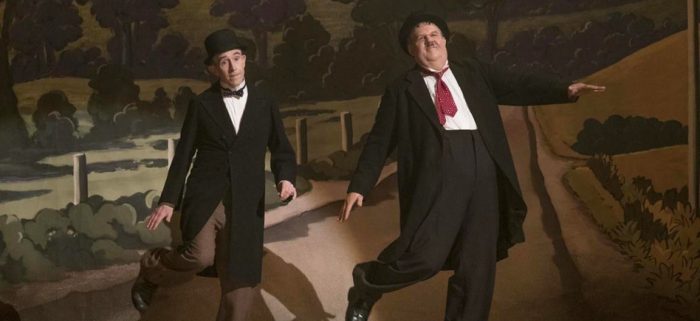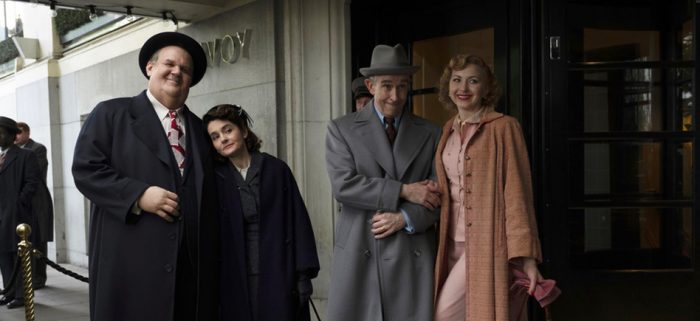‘Stan and Ollie’ Review: Steve Coogan and John C. Reilly Resurrect Laurel and Hardy for a Melancholy Send-Off
Eventually, time comes to claim everyone – even world-famous comedians. Mercifully never dipping into maudlin sad clown territory, Jon S. Baird’s melancholy Stan and Ollie tracks the waning days of the great stage and screen comic duo Laurel and Hardy. Avoiding tedious biopic tropes that focus on how well-known people rose to fame, Stan and Ollie is instead more interested in endings. It’s a film about saying goodbye.
Before he gets to the end of the Laurel and Hardy story, Baird takes us back to the middle. In a wonderfully staged tracking shot designed to appear as if it’s one long take, we follow Stan Laurel (Steve Coogan) and Oliver Hardy (John C. Reilly) in 1937 as they banter and bicker while bustling across a backlot, headed towards Hal Roach Studios. The duo are at the height of their careers, but it’s all about to come crashing down. An argument with producer Hal Roach (Danny Huston in a super-quick cameo) over money ultimately leads to a rift in the double-act, wherein Hardy ends up working with a new on-screen partner, leaving Laurel out of the loop.
Smash-cut to the 1950s. Laurel and Hardy, now looking much older, and much more tired, are together again for a UK tour. The tour is supposed to lead to a new film for the pair that Laurel is writing, but Stan is hiding a big secret: the potential producer has bailed on the project. To add insult to injury, the UK tour isn’t turning out so hot, as the team is stuck performing at under-lit, rinky-dink music halls with sparse audiences in attendance. And while the once-great comedy duo seem happy with each other’s company at first, old resentments are in danger of boiling over.
You can guess where this is going – originality isn’t Stan and Ollie’s strongpoint. Eventually, the two will fight, reconcile, draw huge crowds, and perform one last great show that will leave everyone enraptured. But before that happens, Baird and screenwriter Jeff Pope wisely let their characters breathe, and become fully-formed in the process.
Laurel and Hardy are still well-known today, but it’s safe to say that a large chunk of modern movie audiences know very little about them beyond their physical appearances – one thin, the other fat. But that disconnect allows Stan and Ollie some freedom. Coogan and Reilly do a magnificent job recreating some of Laurel and Hardy’s classic routines, but it’s the quiet, personal moments that stand out. And because the long-dead duo seem so far removed from us today, these portrayals never ring false.
Stan is the brains of the outfit, and Coogan does wonderful work playing the character as someone who knows how smart he is, but doesn’t quite want to rub that brilliance in everyone’s face. He’s equally matched by Reilly, buried in believable make-up, portraying Ollie (or Babe, as everyone calls him) as a fun-loving performer who can never quite turn himself off, often oblivious to the feelings of others in the process, all while his own health problems are quickly catching up to him. Watching Coogan and Reilly bounce off each other is what makes Stan and Ollie so enjoyable – the pair have the perfect amount of chemistry to suggest they’ve been performing together for decades.
More often than not, when true stories about famous men get turned into movies, the females in those men’s lives tend to suffer. Usually, wives and girlfriends in films like this are there to be supportive and little else. Stan and Ollie brilliant subverts this, bringing the duo’s wives into the film midway, and giving them much-needed attention. Shirley Henderson plays the quiet, mousy Lucille Hardy, and Nina Arianda is the loud, unapologetic Ida Kitaeva Laurel, and the pair end up being as funny as their famous husbands. The wives clearly can’t stand each other, and one of the funniest sequences in the film involves some not-so-good-natured back-and-forth ribbing between Henderson and Arianda. It’s refreshing to see the movie give these ladies something to do, and other biopics would be wise to take note.
While all the pieces are here to result in a great film, Stan and Ollie never fully coalesces. Despite the overly somber tone of the proceedings, the execution seems too slight; too airy; and too by-the-numbers. Once the impressive one-take tracking shot in the beginning ends, Baird settles into a much more reserved directorial style. This is likely to reflect the far more reserved latter-half of the duo’s career, but it ends up often casting a pall over the picture as a whole. And the aforementioned predictability doesn’t help.
And yet, it’s hard to resist Stan and Ollie’s charms. Pope’s script has an entertaining way of working some of Laurel and Hardy’s movie slapstick into their everyday lives – a likely embellishment that never seems forced or fake. And the performances from Coogan and Reilly (and Henderson and Arianda) are so lively, so earnest, and so believable that Stan and Ollie is ultimately a success. The sweet sadness that prevails, particularly towards the film’s inevitable conclusion, is touching and brimming with pathos, with the final number that the duo perform being particularly affecting. “I’ll miss us when we’re gone,” Ollie tells Stan right before they take the stage the last time. It’s a sentiment you’ll share, too.
/Film Rating: 7 out of 10
The post ‘Stan and Ollie’ Review: Steve Coogan and John C. Reilly Resurrect Laurel and Hardy for a Melancholy Send-Off appeared first on /Film.
from /Film http://bit.ly/2GFiAfh
via IFTTT


Comments
Post a Comment